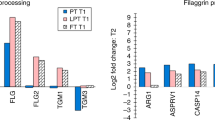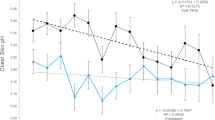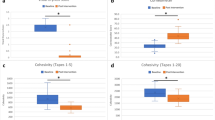Abstract
OBJECTIVES:
To characterize vernix caseosa in newborn infants with respect to factors that influence vernix distribution on the skin surface, vernix effects on thermal stability, skin hydration, acid mantle development, and vernix antioxidant properties.
STUDY DESIGN:
Vernix distribution was determined for 430 infants. Thermal stability was assessed in parallel groups following vernix retention (n=66) and removal (n=64). The effects of vernix retention on skin hydration, pH, erythema, and dryness/scaling were determined. Samples were analyzed for vitamin E before and after UV exposure.
RESULTS:
Vernix distribution depended upon gestational age, delivery mode, gender, race, and meconium exposure. Retention had no effect on axillary temperatures. Skin hydration was significantly higher for vernix-retained skin. Skin pH and erythema were significantly lower with retention. Vitamin E levels were decreased by ultraviolet radiation.
CONCLUSIONS:
Vernix is a naturally occurring barrier cream with multiple salubrious effects, which support its retention on the skin surface at birth.
This is a preview of subscription content, access via your institution
Access options
Subscribe to this journal
Receive 12 print issues and online access
$259.00 per year
only $21.58 per issue
Buy this article
- Purchase on Springer Link
- Instant access to full article PDF
Prices may be subject to local taxes which are calculated during checkout



Similar content being viewed by others

References
Hoath SB, Narendran V, Visscher M . Role and biology of vernix. Neonatal Infant Nurs Rev 2001;1:53–58.
Pochi P . The sebaceous gland. In: Maibach H, Berardesca E, editors. Neonatal Skin. New York: Marcel Dekker; 1982. p. 67–80.
Pickens W, Zhou Y, Wickett R, Visscher M, Hoath SB . Antioxidant defense mechanisms in vernix caseosa: potential role of endogenous vitamin E. Pediatr Res 2000;47 (5):425A.
Narendran V, Hoath SB . Thermal management of the low birth weight infant: a cornerstone of neonatology. J Pediatr 1999;134 (5):529–531.
Vohra S, Frent G, Campbell V, Abbott M, Whyte R . Effect of polyethylene occlusive skin wrapping on heat loss in very low birth weight infants at delivery: a randomized trial. J Pediatr 1999;134 (5):547–551.
Saunders C . The vernix caseosa and subnormal temperature in premature infants. Br J Obstet Gynaecol 1948;55:442–444.
Riesenfeld B, Strombery B, Sedin G . The influence of vernix caseosa on water transport through semipermeable membranes and the skin of full-term infants. In: Second International Conference on Fetal and Neonatal Physiological Measurements. Butterworth Heinemann: Philadelphia; 1984. p. 3–6.
Yoshio H, Tollin M, Gudmundsson GH, et al. Antimicrobial polypeptides of human vernix caseosa and amniotic fluid: implications for newborn innate defense. Pediatr Res 2003;53 (2):211–216.
Marchini G, Lindow S, Brismar H, et al. The newborn infant is protected by an innate antimicrobial barrier: peptide antibiotics are present in the skin and vernix caseosa. Br J Dermatol 2002;147 (6):1127–1134.
Narendran V, Hull W, Akinbi HT, Whitsett JA, Pickens WL, Lambers D . Vernix caseosa contains surfactant proteins: potential role in innate immune function in the fetus. Pediatr Res 2000;47:420A.
Akinbi HT, Narendran V, Pass AK, Markart P, Hoath SB . Host defense proteins in vernix caseosa and amniotic fluid. Am J Obstet Gynecol 2004;191 (6):2090–2096.
Visscher MS, Munson KA, Bare DE, Hoath SB . Early adaptation of human skin following birth: a biophysical assessment. Skin Res Technol 1999;5:213–220.
Pickens WL, Warner RR, Boissy YL, Boissy RE, Hoath SB . Characterization of vernix caseosa: water content, morphology, and elemental analysis. J Invest Dermatol 2000;115 (5):875–881.
Bautista MI, Wickett RR, Visscher MO, Pickens WL, Hoath SB . Characterization of vernix caseosa as a natural biofilm: comparison to standard oil-based ointments. Pediatr Dermatol 2000;17 (4):253–260.
Puhvel SM, Reisner RM, Amirian DA . Quantification of bacteria in isolated pilosebaceous follicles in normal skin. J Invest Dermatol 1975;65 (6):525–531.
Aly R, Maibach HI, Rahman R, Shinefield HR, Mandel AD . Correlation of human in vivo and in vitro cutaneous antimicrobial factors. J Infect Dis 1975;131 (5):579–583.
Thiele JJ, Weber SU, Packer L . Sebaceous gland secretion is a major physiologic route of vitamin E delivery to skin. J Invest Dermatol 1999;113 (6):1006–1010.
Jemec GB, Serup J . Epidermal hydration and skin mechanics. The relationship between electrical capacitance and the mechanical properties of human skin in vivo. Acta Dermatol Venereol 1990;70 (3):245–247.
Okah FA, Wickett RR, Pickens WL, Hoath SB . Surface electrical capacitance as a noninvasive bedside measure of epidermal barrier maturation in the newborn infant. Pediatrics 1995;96 (4 Part 1):688–692.
Akiba T . Studies on biological actions of vernix caseosa. Jpn Obstet Gynecol Soc 1955;2 (4):396–411.
Besch NJ, Perlstein PH, Edwards NK, Keenan WJ, Sutherland JM . The transparent baby bag. A shield against heat loss. N Engl J Med 1971;284 (3):121–124.
Johanson RB, Spencer SA, Rolfe P, Jones P, Malla DS . Effect of post-delivery care on neonatal body temperature. Acta Paediatr 1992;81 (11):859–863.
Saunders C . The vernix caseosa and subnormal temperature in premature infants. Br J Obstet Gynaecol 1948;55:442–444.
Shulak B . The antibacterial action of vernix caseosa. Harper Hosp Bull 1963;21:111–117.
Hoeger PH, Enzmann CC . Skin physiology of the neonate and young infant: a prospective study of functional skin parameters during early infancy. Pediatr Dermatol 2002;19 (3):256–262.
Fox C, Nelson D, Wareham J . The timing of skin acidification in very low birth weight infants. J Perinatol 1998;18 (4):272–275.
Behrendt H, Green M . Skin pH pattern in the newborn infant. Am J Dis Child 1958;95 (1 Part 1):35–41.
Puhvel SM, Reisner RM, Sakamoto M . Analysis of lipid composition of isolated human sebaceous gland homogenates after incubation with cutaneous bacteria. Thin-layer chromatography. J Invest Dermatol 1975;64 (6):406–411.
Herrmann F, Behrendt H, Karp F . On the acidity of the surface of the scalp and other areas of the skin in children. J Invest Dermatol 1946;7:215.
Parra JL, Paye M . EEMCO guidance for the in vivo assessment of skin surface pH. Skin Pharmacol Appl Skin Physiol 2003;16 (3):188–202.
Rippke F, Schreiner V, Schwanitz HJ . The acidic milieu of the horny layer: new findings on the physiology and pathophysiology of skin pH. Am J Clin Dermatol 2002;3 (4):261–272.
Fluhr JW, Kao J, Jain M, Ahn SK, Feingold KR, Elias PM . Generation of free fatty acids from phospholipids regulates stratum corneum acidification and integrity. J Invest Dermatol 2001;117 (1):44–51.
Lukacs A . In vitro control of the growth of important bacteria of the resident flora by changes in pH. In: Braun-Falco O, Korting H, editors. Skin Cleansing with Synthetic Detergents. Berlin: Springer; 1992. p. 97–105.
Thiele JJ, Traber MG, Polefka TG, Cross CE, Packer L . Ozone-exposure depletes vitamin E and induces lipid peroxidation in murine stratum corneum. J Invest Dermatol 1997;108 (5):753–757.
Thiele JJ, Traber MG, Packer L . Depletion of human stratum corneum vitamin E: an early and sensitive in vivo marker of UV induced photo-oxidation. J Invest Dermatol 1998;110 (5):756–761.
Gerloczy F, Bencze B, Ivanyi K . Demonstration of a new biologically active substance vitamin E, in the vernix caseosa. Int J vitamin Res 1961;32:1–4.
Gerloczy F, Bencze B, Ivanyi K . Demonstration of vitamin E, a new biologically active substrate, in the vernix caseosa. Magy Noorv Lapja 1963;26:21–22.
Acknowledgements
This work was supported in part by a grant from the Neonatal Resuscitation Program of the American Academy of Pediatrics and by The Skin Sciences Institute of Cincinnati Children's Hospital Research Foundation. We acknowledge Kathy Spiering and the health care professional staffs at Christ Hospital, University Hospital and Anderson Mercy Hospital for their expert assistance and perseverance in facilitating this research project.
Author information
Authors and Affiliations
Rights and permissions
About this article
Cite this article
Visscher, M., Narendran, V., Pickens, W. et al. Vernix Caseosa in Neonatal Adaptation. J Perinatol 25, 440–446 (2005). https://doi.org/10.1038/sj.jp.7211305
Published:
Issue Date:
DOI: https://doi.org/10.1038/sj.jp.7211305
This article is cited by
-
Assessment of diaper dermatitis using a novel electronic health record-embedded scale
Journal of Perinatology (2023)
-
Early development of the skin microbiome: therapeutic opportunities
Pediatric Research (2021)
-
Premature infant skin barrier maturation: status at full-term corrected age
Journal of Perinatology (2021)
-
Biomarkers of neonatal skin barrier adaptation reveal substantial differences compared to adult skin
Pediatric Research (2021)
-
Besonderheiten und Herausforderungen der neonatalen Dermatologie
Der Hautarzt (2021)


